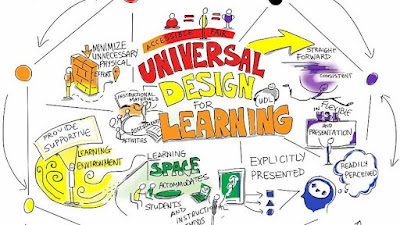Post by Eilís O'Neill, Outreach and Engagement Librarian in DCU Library and member of the libfocus team
 |
| Universal Design for Learning Infographic by DCU TEU 2021 |
So what exactly is UDL, or Universal Design for Learning for those who aren’t in the know? And how can it be applied in our libraries?
The UDL framework is built around a set of best practice principles that offer everyone equal opportunities to learn. More simply put, they are guidelines you can implement when designing your library training sessions and information resources that will reduce barriers to teaching and learning.
UDL-friendly teaching materials and resources are designed to engage all types of learners, taking into account their learning styles, ages, cultural backgrounds, abilities and disabilities. They build flexibility, accessibility, voice and choice into your educational and information offerings, giving users more opportunities to engage with and understand their learning.
.png) |
| Overview of the Universal Design for Learning Framework DCU TEU 2021 |
I recently completed a UDL badge facilitated by Dublin City University, in partnership with the National Forum for the Enhancement of Teaching and Learning in Higher Education. Through individual and group activities I learned how to reflect on the diversity of the staff and students in DCU. I also gained an understanding of how to support diverse learners in the library by viewing our resources and communications through a UDL lens.
As part of the UDL course, I incorporated UDL principles into the Library’s online guide to our Live Wise Book Therapy collection. The collection supports self-care for DCU’s staff and students and a project team I was part of was in the process of updating the original 2014 guide. I used the UDL guidelines to figure out how to improve the accessibility of the guide and to make sure that it was catering for different styles of learners.
The original guide focused on books and eBooks as the primary learning resources, so I also added videos and podcasts. These additional learning materials will cater for staff and students who learn more effectively using audio-visual resources. They take into account the different learning styles of our users and offer additional support to learners from different social and cultural backgrounds.
The UDL framework shows you how to help staff and students persist with their learning, to engage more meaningfully with resources and to incorporate what they learn into their day-to-day lives. To support this I added a section to the guide’s homepage highlighting the importance of setting goals, taking notes and tracking and sharing performance.
Ensuring your library resources are as accessible as possible is an important part of making them more UDL-friendly. With this in mind, I checked that all the videos and podcasts I added were captioned. (See this libfocus post I made earlier which outlines the benefits of providing video captions to learners). The project team added alt text to the images in the guide where relevant, making the guide more accessible to staff and students using assistive technologies such as screen readers.
One of the important lessons I learned during the course centred around the language we use when sharing information with our learners. This applies to the text on our library website, our social media and email communications and the descriptions we use across our information resources. The use of plain language ensures that learners understand the information we’re sharing quickly, easily and as completely as possible.
The book descriptions in the guide had been adapted from the publisher’s promotional material. They often contained unnecessarily complex language, industry jargon and run-on sentences. By rewriting the descriptions in plain language and by breaking down long sentences I was able to make the text suitable for people reading English at all levels.
 |
| The Live Wise Book Therapy Collection Guide DCU Library 2023 |
The UDL guidelines taught me that learners engage more effectively with library resources if they’re given the opportunity to share their views about them. To facilitate this, I created a feedback page on the guide which invites users to submit their opinions about the guide’s content and layout. This feedback will be used to improve the guide and will help us to gauge if it’s meeting the needs of our staff and students.
Making your library more UDL friendly can be as simple as adding alt text to images you share on social media, or by providing information with a HTML document, rather than in PDF format only. The key aim is to think beyond the idea of the ‘average’ student when designing your library resources and training sessions so that they take the diversity of your staff and students into account.
The National Forum for the Enhancement of Teaching and Learning in Higher Education is running an open access UDL badge course in October – you can register your interest in the course from August 2023. I highly recommend completing the course if you can, it will open your eyes to the ways you can make your library services, expertise and resources available to all of your users equally and break down barriers to teaching and learning.




0 comments:
Post a Comment